Madhya Pradesh Tour
Explore Madhya Pradesh – The Heart of Incredible India
Madhya Pradesh, centrally located in India, is a land of rich heritage, mystical temples, royal forts, and thriving wildlife. This tour takes you through UNESCO World Heritage Sites like Khajuraho and Sanchi, historical towns like Gwalior and Orchha, and renowned national parks such as Bandhavgarh and Kanha. Experience the spiritual, cultural, and natural diversity that defines this incredible state.
Madhya Pradesh Tourism
Explore the beauty of the largest state of India- Madhya Pradesh which is located at the central India, and therefore recognized worldwide as the "heart of India". Tourism to Madhya Pradesh has a lot to offer to its first time visitor ranging from exquisitely carved temples, innumerable wildlife sanctuaries to landscaped hill towns and monasteries. Just like Madhya Pradesh tourism has a lot to offer for its gamut of visitors, similarly we at "ITS" offer you diverse Madhya Pradesh tour packages in order to enrich you with the real taste of the central India.
No matter for whatever purpose you are planning your travel to Madhya Pradesh; with our diversified Bhopal tour, khajuraho travel and tour packages, etc. packages we are going to provide you glimpse of varied sites of Madhya Pradesh within your desired budget.
Bhopal
Avail our tailor-made Bhopal tour packages at inexpensive prices which are going to cover some of the main sightseeing places of Bhopal like Bharat Bhavan, Moti Masjid, Shamla and Idgah hills, Taj-ul-Masjid and many more.
Altitude: 572 meters, Climate: (deg C)-Summer- Max 47.7, Min 24.9; Winter- Max 24.5, Min 9.1, Best Season: October to March.
Places Of Interest
Taj-ul-Masjid , Juma Masjid , Moti Masjid, Shaukat Mahal , Bharat Bhawan and Roopankar, Shamla and Idgah Hills. Chowk, Upper and Lower Lake , Gandhi Bhavan, Van Vihar.
Excursions
Bhimbetka- 40 kms, Bhojpur- 28 kms, Chiklod- 45 kms, Dhelwadi- 62 kms, Islamnagar-11 kms, Neori- 6 kms, Raisen- 47 kms, Sanchi- 46 kms, Vidisha- 56 kms, Ginnorgarh Fort- 61 kms.
Reach
By Air: Well connected with all major towns.
By Rail: Bhopal is well connected with all major cities.
By Road: Bombay- 789 kms, Aurangabad- 588 kms, Ahmedabad- 571 kms, Agra- 523 kms, Delhi- 728 kms, Gwalior- 422 kms, Gwalior- 422 kms, Indore-187 kms, Ujjain- 189 kms, Sanchi- 46 kms, Khajuraho- 387 kms, Mandu- 290 kms, Pachmarhi- 210 kms.
Sanchi
In India, Sanchi is one such a destination which is often considered as a hub of monasteries, temples, stupas n pillars of 3rd century BC to the 12th century AD. The Sanchi Stupa, Ashoka Pillar, Buddhist Vihara are some of the best places to rove around while planning for a Sanchi, Indian tour.
Altitude: 427 meters, Climate: (deg C)-Summer- Max 45, Min 25; Winter- Max 22.5, Min 10, Best season: October to March.
Places Of Interest
Great Stupa No.1, Toranas or Gateways, Stupa No. 2, Stupa no. 3, Ashoka Pillar, Buddhist Vihara, Monasteries.
Excursions
Andhara and Pipalilya- 17.7 and 12 kms, Besnagar- 12 kms, Gyaraspur- 41 kms, Raisen Fort- 23 kms, Sonari and Satdhara-10 kms, Udaigiri- 13 kms.
Reach
By Air: Nearest airport is Bhopal- 46 kms.
By Rail: Nearest railhead is Bhopal 46kms.
By Road: Bhopal- 46 kms, Vidisha- 10 kms, Indore- 232 kms etc.
Gwalior
According to a legend, Gwalior derives its name from a great sage Gwalipa who cured a chief of the Kachwaha clan suffering from leprosy. Gwalior’s strategic position between north and south India made it an important possession and was captured by several ruling houses. The first historical holders of the city were the Huns. Held in succession by the Mughals, Jats, Marathas and the British, Gwalior was finally handed over to Jiyaji Rao Scindia at a formal durbar in 1885.
The Scindias were the last ruling family of Gwalior and are still influential in the political arena of India. It is also sacred to the memory of the heroic queen Rani of Jhansi and Tatya Tope.
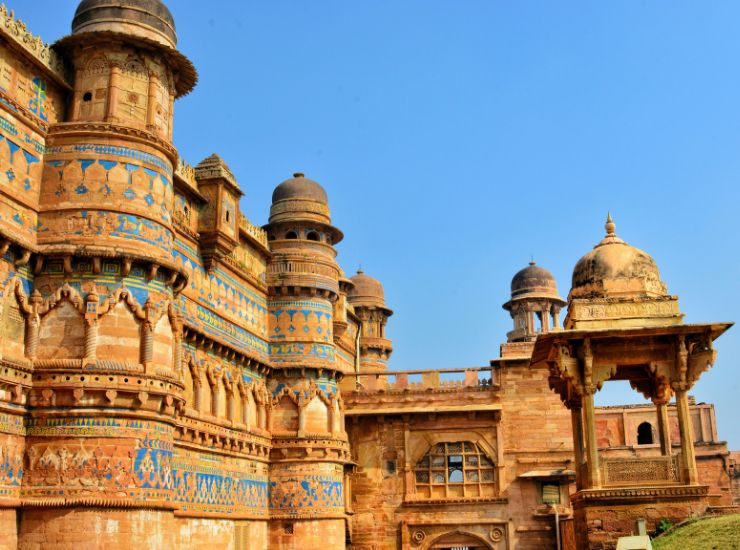
Area: 82 sq. km, Altitude: 212 meters, Climate: (deg C) – summer 46 Deg. 21 Deg. Winter: 22 Deg. 6 Deg, Best Season: October to March.
Places Of Interest
The Cenotraphs, Man Singh Palace, Man Mandir Palace, Gujari Mahal, Suraj Kund, Teli ka Mandir, Sas Bahu ka Mandir, Rani Jhansi Memorial, Tombs of Tansen and Ghaus Mohammad, Jai Vilas Palace, Gandhi Park, Zoo Municipal Corporation Museum, Jivaji Rao Scindia Museum.
Excursions
Tigra's Dam- 23 kms, Pawaya- 68 kms, Datia- 68 kms, Orchha- 120 kms, Shivpuri- 112 kms, Chanderi- 209 kms, Narwar– 128kms, Narwar Fort.
Reach
By Air: Well linked all with major towns.
By Rail: Gwalior is connected to all major cities in India.
By Road: Agra- 118 kms, Bhopal- 420 kms, Delhi- 318 kms, Khajuraho- 280 kms, Sanchi- 344 kms, Shivpuri- 112 kms, Indore- 486 kms, Bombay-1086 kms.
Orchha
The medieval city of Orchha, in the state of Madhya Pradesh, seems to have frozen in time, its palaces and temples still retaining their original grandeur. Orchha had the distribution of being the capital of one of the largest and most powerful kingdoms of Central India. The Bundela Rajput chieftain, Rudra Pratap, founded the city, located by the side of the beautiful Betwa River, in the 16th century. The word Orchha means 'hidden'. When the Tughlaqs, who were ruling Delhi in the 15th century, pushed the Bundelkhand rajas out of Garkhundar, they retreated to distant Orchha.
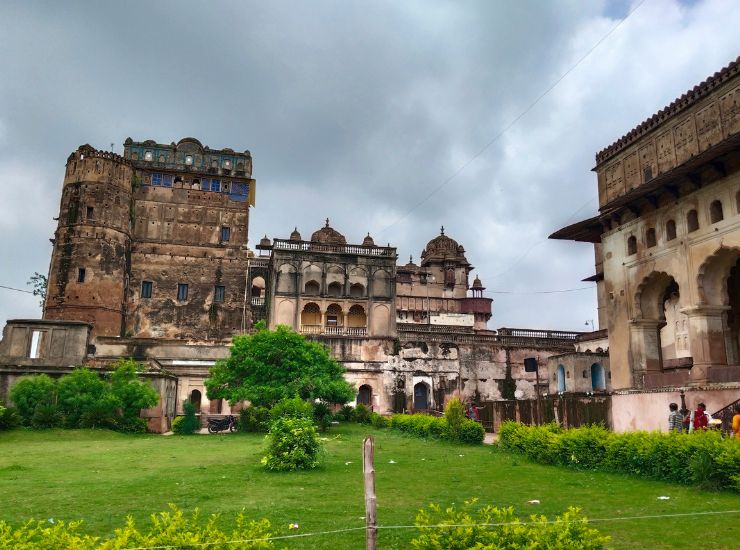
Places Of Interest
Jehangir Mahal, Raj Mahal, Raj Praveen Mahal, Ram Raja Temple, Chaturbhuj Temple, Laxmi Narayan Temple, Phool Bagh, Dinman Hardaul's Palace, Sunder Mahal, Cenotraphs, Shahid Smarak.
Reach
By Air: Nearest airport is Gwalior -120 kms.
By Rail: Nearest railhead is Jhansi -19 kms.
By Road: Orchha lies on the Jhansi - Khajuraho road.
Khajuraho
Travel to Khajuraho for having a glimpse of internationally famous erotic sculptures of several Khajuraho temples. The divine sculptures in these temples epitomize the artistic work for numerous craftsmen who have built these temples under the patronage of Chandela Rajput Kings. Kandariya Mahadeo temple, Chitragupta temple, Lakshman Temple, Vishwanath Temple, etc are some of the masterpieces of ancient times.
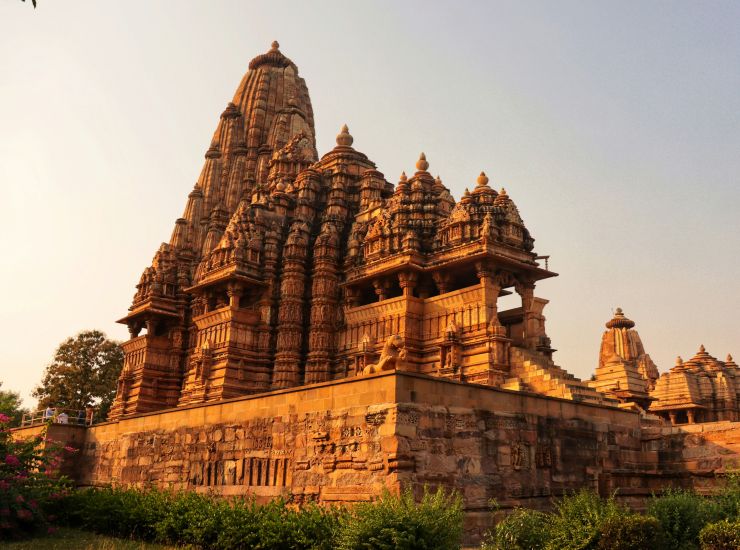
Climate: (deg C) -Summer 47 Deg. C. 21 Deg. C, Winter 32 Deg. C. 4 Deg. C, Rainfall: 114 cm. (July-September), Best Season: October to March.
Places Of Interest
The temples of Khajuraho are divided into three geographical groups viz, Western, Eastern, and Southern groups.
Excursions
Dhubela Museum- 64 kms, Beni Sagar- 11 kms, Panna Diamond Mines- 56 kms, Panna National Park- 60 kms, Pandav Falls- 35 kms, Raigarh Palace- 25 kms, Raneh Falls- 20 kms, Ranguan Lake- 25 kms, Ajaygarh Fort- 80 kms, Kalingar Fort- 125 kms, Nachana- 100 kms.
Western Group of Temples
Chausath Yogini Temple, Kandariya Mahadeo Temple, Devi Jagdamba Temple, Chitragupta Temple,Vishwanath Temple, Parvati Temple, Lakshmana Temple, Matangeshwara Temple.
Eastern Group of Temples
Brahma Temple, Vamana Temple, Parsvanath Temple, Ghantai Temple.
Southern Group of Temples
Dulhadeo Temple, Chaturbhuj Temple, Archaeological Museum.
Reach
By Air: Well connected with Delhi.
By Rail: Jhansi-175 kms, Satna-117 kms, Harpalpur-110 kms.
By Road: Agra- 395 kms, Allahabad- 285 kms, Bandhavgarh- 237 kms, Bhopal- 372 kms Chitrakoot- 176 kms, Delhi- 590 kms, Jabalpur- 296 kms Lucknow- 267 kms, Varanasi- 415 kms.
Indore
Planned and built by Rani Ahilyabai, the brave Holkar queen, Indore lies to the extreme west of Madhya Pradesh on the banks of the rivers Saraswati and Khan which unite at the centre of the city. Indore derives its name from the 18th century Indreshwar Temple. The history of Indore is inseparable from the history of the Holkar State. The founder of the House of Holkars was Malhar Rao Holkar, born in 1693 AD. Ahilya Bai was one of the foremost Maratha personalities and an extraordinary woman ruler of India. She was the rare Indian royalty who was deified in her lifetime.
Though Ahilya Bai loved Indore immensely, it was only after her death that the State capital was shifted from Maheshwar to Indore in 1811 AD. Today, her statue adorns the centre of the city, Rajwada.
Climate: (deg C) - Summer Max- 40.5, Min- 27; Winter Max- 30.4, Min- 15, Rainfall: 110 cms (July to September), Best Season: September to March.
Places Of Interest
Chhatri Bagh, Gita Bhavan, Lalbaug Palace, Bada Ganapati, Juna Rajwada, Kanchi Mandir or Hukumchands Temple, Annapurna Temple, Kendriya Sangrahalaya.
Excursions
Bagh Caves-153 kms, Ujjain- 53 kms, Mandu- 99 kms, Maheshwar- 90 kms, Omkareshwar- 77 kms.
Reach
By Air: Indore is well linked all major cities.
By Rail: Indore is well connected to major cities of India.
By Road: Agra- 605 kms, Ahmedabad- 456 kms, Bhopal- 187 kms, Bombay- 602 kms, Delhi- 809 kms, Gwalior- 486 kms, Khajuraho- 574 kms, Maheshwar- 90 kms, Mandu-105 kms, Ujjain- 53 kms.
Ujjain
One of the main venues of Kumbh Mela; Ujjain city is famous for offering myriad sacred and stunning sites like renowned Ujjain Mahakali temple, Sandipani Ashram, Shipra Ghats, Vikramaditya University, etc.
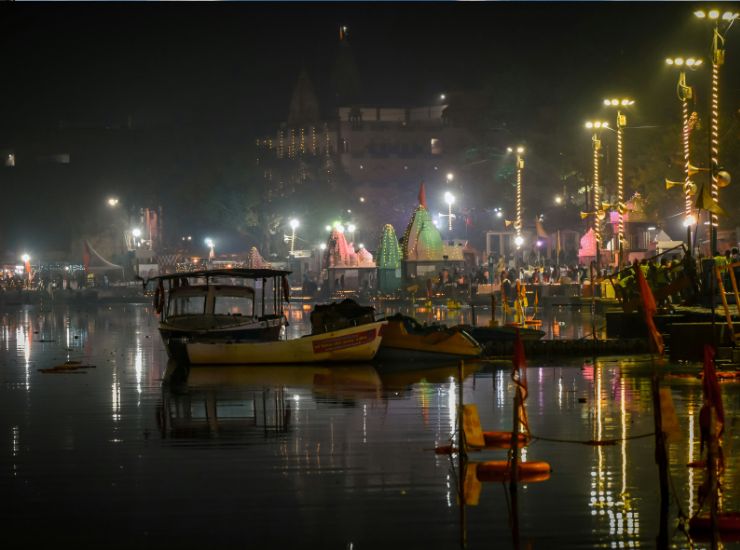
Altitude: 492 meters, Climate: (deg C)- Summer- Max. 40, Min. 20; Winter- Max. 28, Min. 10, Rainfall: 101 cms (July to September), Best Season: September to March.
Places Of Interest
Bharatahari Cave, Gopal Mandir, Jantar Mantar, Kailadah Palace, Mahakali Temple, Sandipani Ashram, Shipra Ghats, Vikram University Museum.
Excursions
Agar- 66 kms, Devas- 37 kms, Maksi- 39 kms, Nagada- 60 kms.
Reach
By Air: Nearest Airport is Indore-53 kms.
By Rail: Ujjain is well connected to all major towns.
By Road: Ahmedabad- 402 kms, Bhopal-183 kms, Bombay- 655 kms, Delhi- 774 kms, Gwalior- 451 kms, Indore- 53 kms and Khajuraho- 570 kms.
Kanha National Park
Kanha National Park in the Mandla District spreads over 1,945 sq.km of dense sal forests, interspersed with extensive meadows and trees and clumps of wild bamboo Situated in the Indian state of Madhya Pradesh, the picturesque Kanha National Park was the inspiration behind Rudyard Kipling's unforgettable classic Jungle Book. By far the most striking features of this region are the open grassy meadows, where sighting blackbuck, swamp deer, sambhar and chital is common. And, if one can transcend into time, a barefooted Mowgli would perhaps come padding along the dusty trail, for this is the land of Kipling's Jungle Book.
If one were to point to the middle of India, chances are he will pick out the forests of the Banjar and the Halon valley, the two forming the western and eastern halves of the Kanha Tiger Reserve, which have long been famous for their wide diversity of wildlife.
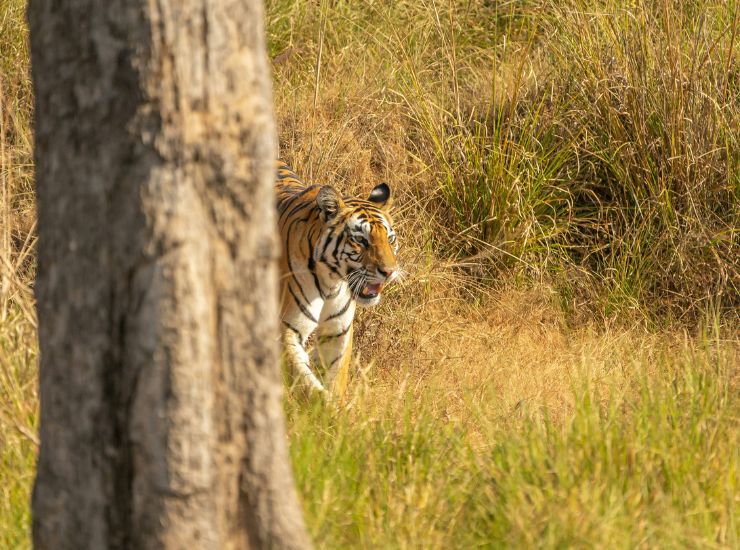
Area: 1,945 sq.kms, Altitude: 600-900 meters. Climate: (deg C)-Summer- Max 40.6, Min 23.9; Winter- Max 23.9, Min 1.1. Rainfall: 152 cms, Best Season: April to June and November to January. (The park is closed from July to Mid November during monsoon)
Wildlife in the park
The main attractions are Tiger, Bison, Gaur, Sambar, Chital, Barasingha, Barking Deer, Black Deer, Black Buck, Chousihgha, Nilgai, Mouse Deer, Sloth Bear, Jackal Fox, Porcupine, Hyaena, Jungle Cat, Python, Pea fowl, Hare, Monkey, Mongoose, Tiger, Leapord etc. can also be seen here.
Birds species in the park
Storks, Teals, Pintails, Pond Herons, Egrets, Peacock, Pea Fowl, Jungle Fowl, Spur Fowl, Patridges, Quails, Ring Doves, Spotted Parakeets, Green Pigeons, Rock Pigeons, Cuckoos, Papihas, Rollers, Bee Eater, Hoopes, Drongos, Warblers, King Fishers, Wood Peckers, Finches, Orioles, Owls, Fly Catchers.
Reach
By Air: Nagpur- 266 kms is the nearest airport.
By Rail: Jabalpur-169 kms is the nearest rail.
By Road: Jabalpur- 175 kms, Khajuraho- 445 kms, Nagpur- 266 kms, Mukki -25 kms, Raipur- 219 kms.
Bandhavgarh National Park
Set amongst the Vindhyas, in Madhya Pradesh, Bandhavgarh is a small national park, but with the highest known density of tiger population in India. This is also known as White Tiger territory. These have been found in the old state of Rewa for many years. Besides its enchanting landscape formed by the Sal forest in the valleys and majestic tree clad hills in the back-drop. The Park is spread over an area of 437 sq. km.The terrain is made of rocky hills, sal forests and grazing areas, formerly agricultural land.
The finest of these hills is the Bandhavgarh hill, and on its highest point stands Bandhavgarh Fort.
Several dynasties have ruled the fort: for example, the Maghas from the 1st century A.D, the Vakatakas from the 3rd century; the Sengars from the 5th century, and the Kalachuris from the 10th century.The oldest signs of habitation, are the caves dug into the sandstone, near the fort. Several of these contain Brahmi inscriptions dating from the 1st century B.C.
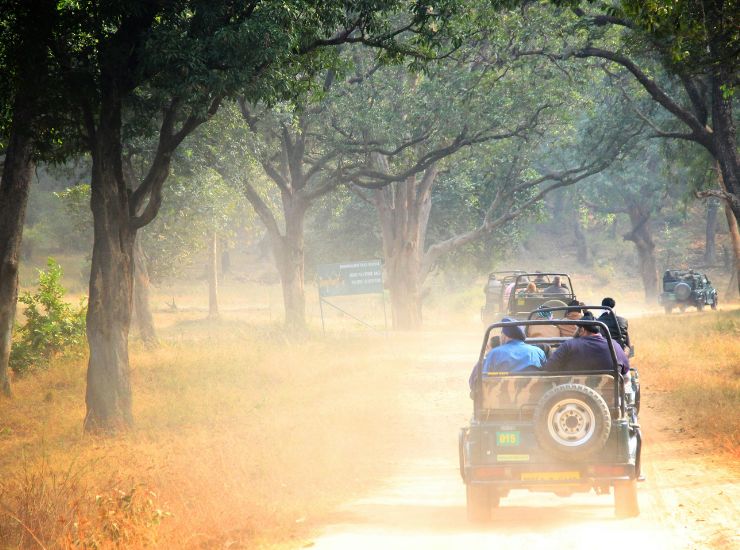
Area: 280 sq. kms, Altitude: 400 to 810 meters, Climate: (deg C)-Summer- Max 41.4, Min 26; Winter- Max 21.1, Min 9.6, Rainfall: 1174 mms, Best Season: March to June. The park is closed from July to Mid-November.
Wildlife in the park
Tiger, Leopard, Bear, Bison, Chital, Sambhar, Nilgai,Chinkara, Chowsingha,Barking deer, Wild Pig, Hyaena, Porcupine.
Birds species in the park
Peacock, Paradise fly catchers, Jungle Fowl, Golden and Black headed Orioles, Yellow Ioras, Red-vented Bulbuls, Blue Jays, Purple Sunbirds, Green Barbets and Mynahs.
Reach
By Air: Khajurao- 230 kms is the most nearest airport.
By Rail: The nearest railhead Umaria- 30 kms and Satna- 117 kms.
By Road: Khajuraho- 230 kms, Varanasi- 340 kms, Katni- 75 kms, Rewa- 115 kms, Umaria- 30 kms, Kanha- 250 kms.
Mandu
Mandu, or the ”City of Joy”, is a superb hilltop fort, deserted, dramatic, and alive with ghosts! It is a dream city steeped in legends of the love of Baz Bahadur for his beloved Rani Roopmati. Breathtakingly beautiful, this former capital of the Sultanate of Malwa is perched high on a hill in the central Indian state of Madhya Pradesh, 283 km away from the capital city Bhopal. A ghost city now, Mandu was once the monsoon retreat of the Mughal emperors. For one thing, Mandu is far from the coast. It does not have the sort of sluicing rain that inundates some of our seaboard destinations. Moreover, Mandu is on a plateau and regardless of how much it rains, the water pours off in silver-threaded waterfalls which gives it a sort of designer magic that no designer but only nature can replicate. And finally—and this is a big plus—many of the monumental buildings of Mandu have been fashioned to use this play of water and rain-heavy thunder clouds to superb effect.
You’ll get an inkling of what you should expect in Mandu when you drive through the sub-montane lands that lead up to the plateau. Rising out of the tangles of scrub vegetation are no-nonsense, foursquare, staging posts for horse-mounted messengers and guardhouses. Some of them have domes which look rather like the qullas, or foundation caps around which some turbans are tied. Then the road winds up and pierces the edge of the escarpment through a succession of massive gates. It is only then that one enters the hamlet of Mandu flowing through the old monuments. The living hamlet and the well-preserved ruins now form a seamless whole and it is virtually impossible to see where one ends and the other begins.
Sightseeing
Mandu has over 40 monuments to choose from. For convenience, these are divided into three broad groups: the Central Village Group, the Royal Enclave Group, and the Rewa Kund Group. You can easily spend all day in Mandu, wandering in and out of palaces, pausing to admire the beauty of the Champa Baoli, the former baths, and the huge 15th-century Jami Masjid, the finest example of Afghan architecture in India. Then there are the beautiful Jahaz Mahal (ship palace), where the architectural illusion is completed by the two surrounding lakes; the Hindola Mahal, or swing palace; the romantic Baz Bahadur’s Palace and Roopmati’s Pavilion; and Hoshang Shah’s Tomb, the final resting place of the founder of Ghuri Dynasty. Besides, there are many palaces, pavilions, and reservoirs where you can spend a leisurely day taking in the city’s rather turbulent history, which is not revealed by the monuments that speak of luxurious royal lifestyles.
Excursions
Mandu can be made the base for visiting several important destination of south Madhya Pradesh. The Bagh Caves (50 km) are Buddhist viharas that were excavated on the perpendicular rock face of a hill. Of particular interest here are the mural paintings drawn by master painters of ancient India. Another religious place near Mandu is Omkareswar. The site of the famous Omkareswar Mahadeo temple, Omkareswar houses one of the 12 jyotirlingas of India. Then there is Maheshwar, a temple city that finds mention in the Mahabharata and Ramayana. The Mahishmati of yore, Maheshwar is also a household name for its unique Maheshwari saris.
For every visitor, choices regarding Madhya Pradesh tour packages are limitless as our tour packages ideally combines major attractions of many destinations like famous Ujjain temples, Khajuraho temples, etc. Everlasting fun is not limited to temples only; one can make his trip memorable by spotting the tiger at wildlife parks of a state on one hand and interacting with the local tribes of the state on another.
Therefore, travel to Madhya Pradesh by attaining our Madhya Pradesh tour packages which can be customized further as per your preferences. In addition to this, we also make accommodation arrangements in various well-equipped hotels to make your Madhya Pradesh and Bhopal tours memorable one.
Customize Your Madhya Pradesh Tour
This is a private individual tour and can be fully customized to suit your available days, travel preferences, and budget. Our experts are ready to help you create a bespoke tour just for you.
To get started, please contact us with the following details:
- Number of days for touring in India.
- Period of travel (Month of the year)
- Number of people travelling.
- Choice of destination in India (North, South, East, West)
- Choice of Hotels accommodation (Economy, Standard, First Class, Premium)
Send us an email on info@tour-india.net or submit the form with your queries, we will reply you with your tour within 24 hrs. *
East India
West India
North India
South India
Plan Your Journey Today
Ready to explore the wonders of India? Contact us to customize your tour package and embark on a journey of a lifetime.
